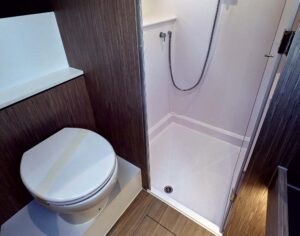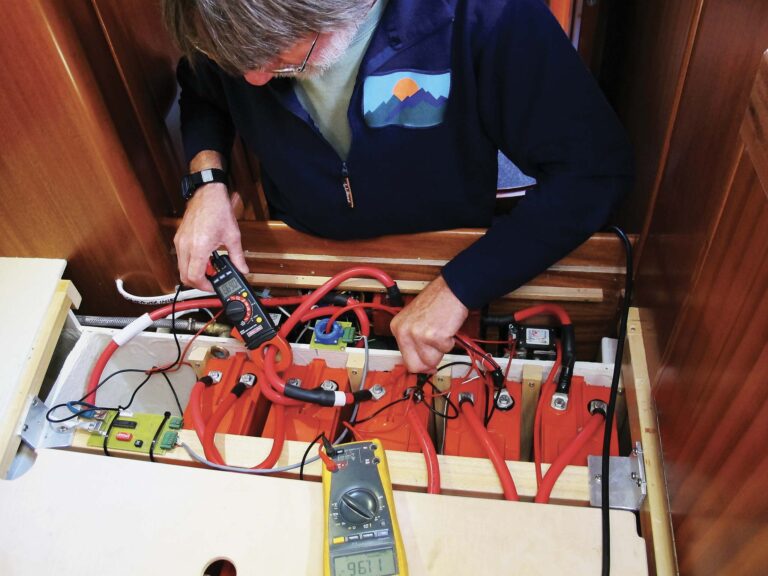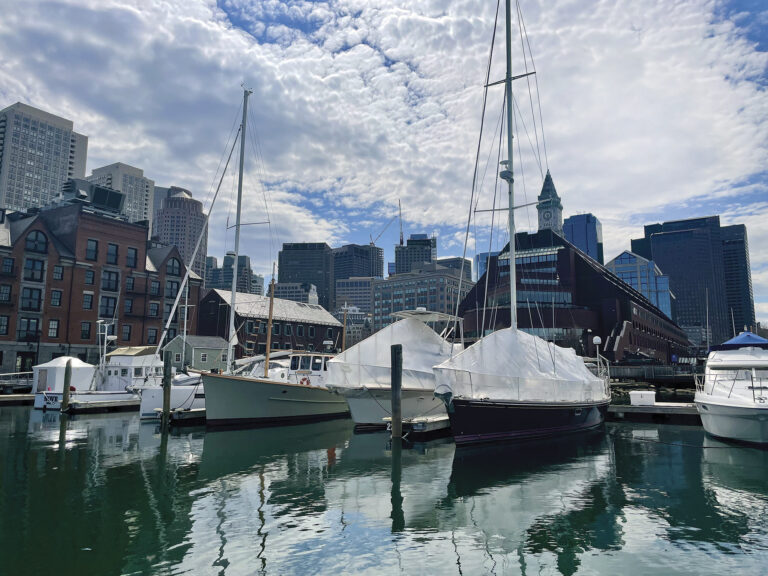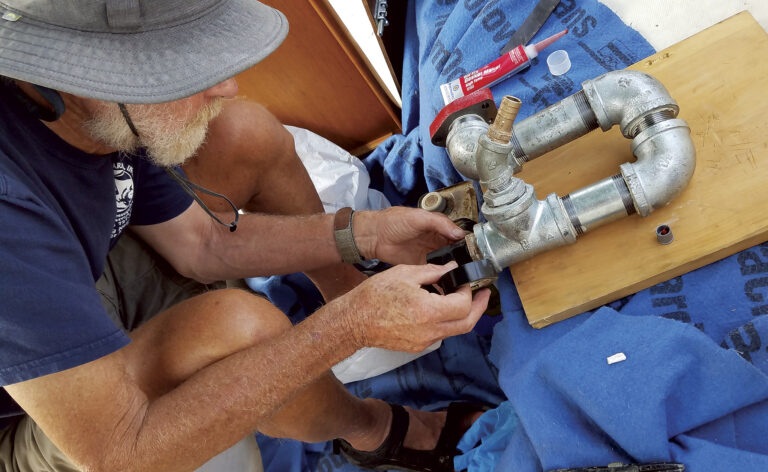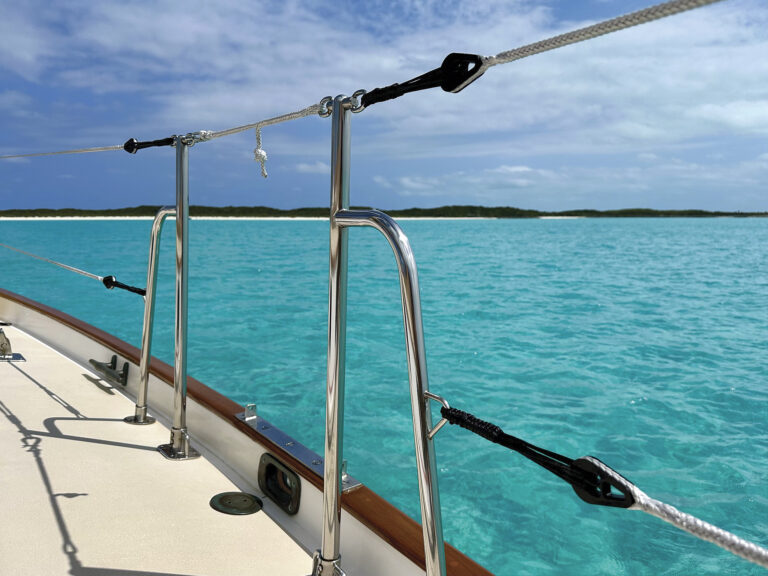
Is your deck starting to look a bit rough around the edges? Is the antiskid failing? Do you slip and slide a lot when going forward? If so, maybe there’s a paint job in your future. Painting an antiskid deck is a fairly easy DIY job and can save you lots of money. It also can make your boat look fabulous and cut down the glare on your deck when the sun is in your eyes.
Prep Work
Your first task is to remove all the deck gear. You can work around hardware and fixtures like grabrails by masking them off, but it is best to remove as much as possible. While doing so, inspect the deck carefully. You want to make any needed repairs, particularly those involving saturated deck core, before you paint. If you’re upgrading your deck hardware, you may need to fill old fastener holes. You may also find cracks and dings that need fixing (“Repairing Deck Dings”).
After making any needed repairs, you are ready to sand. In most cases you need not do a lot of this. The glossy parts of the deck that are free of antiskid should be sanded and undercoated, but to my mind there is no point in sanding off an existing antiskid surface. All you need to do is smooth out any lumps or bumps you made when filling holes and cracks.
Use 220 grit paper for really rough areas, then work up to 320 grit, as this provides a good tooth for the new paint. If possible use a random orbit rotary sander and make sure you remove any swirl marks by sanding them off with a finer grit paper.
Next vacuum the deck and wipe it down with a solvent. Many painters use acetone, but it dries very quickly and often leaves some surface residue. Most yard painters use Dupont’s Prep-Sol, but this might be hard to find if you’re not a professional. Most paint manufacturers offer solvents recommended for use with their paints. For example, I use Interlux’s 2333N. This is a slower-drying solvent that allows you to wipe the surface completely clean. When using any solvent be sure to wear rubber gloves and keep it off your skin.
Choose Your Paint
What color will you paint the areas between the antiskid sections of your deck? That’s your first decision. It’s best to choose a color that provides a distinct contrast with the antiskid so your crew can easily see which parts of the deck are slippery and which are not.
As for the much larger antiskid portion of your deck, it can be most any color you please. Appropriate paints come in a variety of colors and can be mixed if you like. For the antiskid sections it’s a good idea to “flatten” the paint if it’s glossy. Be sure to stir the flattener in well so it is spread evenly throughout the paint.
You also need to decide how you’ll create your antiskid surface. I have tried three options: 1) use a paint (such as Interlux’s Interdeck) that already contains an antiskid compound; 2) mix an antiskid compound into a paint; and 3) paint the deck once, sprinkle on an antiskid compound while the paint is still wet, then paint again.
Of these, option 1 is by far the easiest. All you need to do is open the can, stir the paint, and roll it on. Color choices, however, may be limited. If you go with options 2 or 3, you’ll find there are various antiskid additives to choose from. It’s best to use a compound offered by the company that makes the paint you’ve chosen. For example, I like Interlux products, and they offer an antiskid product, Intergrip, that can be added to any Interlux paint.
If you want to make your own antiskid compound, you can try using ground walnut shells or sand, but be warned. Walnut shells can add a brownish hue to paint, and sand can be too abrasive. Sand also does not absorb paint and tends to break loose from dried paint sooner rather than later. Whatever you do, don’t use beach sand. It may contain salt, which will degrade the paint.
Applying the Paint
Only paint when temperatures are above 55 degrees. If you paint in lower temperatures, your paint may never dry completely. The ideal temperature is between 55 and 70 degrees with low humidity.
The two preferred application methods for DIY painters are brushing or rolling and tipping. If you intend to simply brush on paint, be sure to use a high-quality brush. Apply the paint in one direction, then brush gently against your first pass at a 90-degree angle. You should first paint the areas between the antiskid sections of the deck and try to start and finish your brush strokes in areas that will later be covered with antiskid. Feather the dry edge carefully to avoid leaving a sharp ridge of paint.
To roll and tip, first roll the paint on using a sponge roller that’s designed for use with polyurethane paints. Roll a layer of paint on over a limited area, then, using a good quality dry brush, gently drag the brush over the wet paint. Again, do the glossy bit between the antiskid areas first and begin and finish your strokes in the antiskid zone, being careful not to leave ridges.
You should start by painting the cockpit sole and then work forward. Most beginners start forward and end up painting themselves into the cockpit. They end up having to scramble out over wet paint or are trapped until the paint dries. Also, do not apply too much paint. A thick paint layer may not dry and when you walk on the deck you will break through the “skin” and walk paint all over your nice new deck.
You should apply a second coat if your first coat hasn’t covered everything completely. It’s best to apply your second coat as soon as the first is dry, which usually takes at least 48 hours. If you put on the second coat too soon, the underlying coat may not get enough air and may take weeks or even months to completely dry.
Masking off
Once the paint between the antiskid sections of the deck is completely dry, you can mark out the antiskid areas and tape them off. Use a good-quality masking tape and press it down well so the paint doesn’t leak under the tape. Tape over the corners, then use a quarter or a small paint can as a template to cut in a nice radius. Do this on every corner and be sure to cut the masking tape with a sharp X-acto knife. This is tedious, but needs to be done well if you want a really superb-looking finish.
With everything masked off, check around the boat to ensure you’ve hit every corner and every edge. It is very easy to miss one or two corners. Wipe down the antiskid areas with solvent, being sure to keep your hands and feet off them. Professionals often renew the masking tape after wiping down with solvent. Wear plastic boots if necessary.
Again, when applying your antiskid paint, start with the cockpit sole and work forward. If there are tricky areas you cannot reach with a roller, use a sponge brush to get at them and gently dapple the area to get a consistent antiskid look.
If you are using paint with an antiskid compound mixed into it, it is good idea to stir the paint frequently to make sure the compound is evenly distributed. If you are sprinkling on compound between coats, let the first coat with sprinkled-in compound dry overnight. Next day vacuum up any loose compound before applying the second coat.
Finishing Up
Before the paint is completely dry—about 8 to 12 hours after you’ve finished, depending on temperature—carefully peel off all the masking tape. If you leave the tape until the paint has completely hardened, it may be difficult to remove. Pull the tape straight up and away from the deck so that any tacky paint on the tape will not mar the new surface. Next let the paint harden for at least 72 hours; a week is better.
Go around your nice new deck and check to see if any paint leaked under the masking tape. If it did, you can either scrape it off carefully with an X-acto knife or touch it up with an artist’s brush. Work carefully and let the new paint dry before walking on the deck.
If you keep street shoes off your deck, your new paint job will last a lot longer. Street shoes bring aboard dirt and grit that soon ruins deck paint. If you ask your crew to wear only sailing shoes while working onboard, your new paint job may last up to five years.


